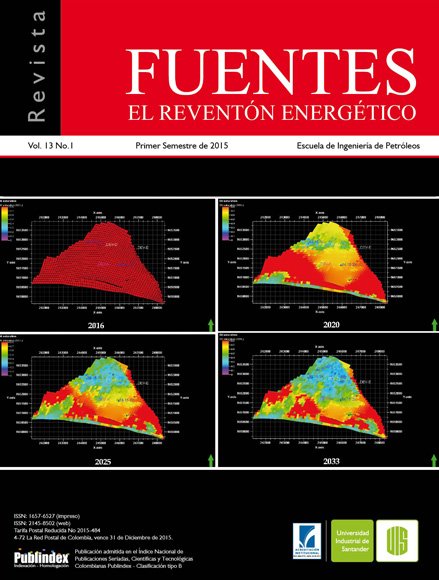Reduction acidity of a crude oil with an alcohol ionic liquid 2-methylimidazole solution
Published 2015-08-11
Keywords
- Crude,
- Naphtenic Acids,
- TAN
How to Cite
Abstract
The objective of the investigation was the reduction of the acidity of a Colombian crude (Total Acid Number (TAN) of 4,9 mg KOH/ g crude) utilizing an ionic liquid formed in-situ with ethanolic solution 2 methylimidazole to extract the acid compounds. Experimental designs were realized 2[3] with a point and a half and triplicated whose independent variables were: relationship crude: reactives, in between reactives (2 methylimidazole: Ethanol) and the period; the dependent variable was the percentage of the reduction of acidity.
The best conditions for the majority acid extraction were: a relationship between crude: reactive (1: 0,2 w: w), a relation 2-methylimidazole: ethanol at (20% w/v), and an agitation period of 3 minutes. The maximum acidity removal percentage was 83%. The 2-methylimidazole demonstrated to be an alternative organic base for the reduction of the acidity mixture of oil, substituting the inorganic bases commonly utilized that generated problems like emulsions and loss of oil. The ethanol was an excellent solvent due to the acid mixture was soluble in it and there was no loss of oil in the process.
Downloads
References
2. Bicak, N.yazi, B. (2005). A new ionic liquid: 2-hydroxy ethylammonium formate. Journal of Molecular Liquids, 116, 15– 18.
3. Borges, B., and Acevedo, S. (2007). Caracterización estructural de distintas fracciones aisladas del crudo extrapesado Carabobo. Revista Latinoamericana de Metalurgia y Materiales, 27, 83-94.
4. Ding, L., Rahimi, P., Harkins, R., Bhatt, S., and Shi, Y. (2009). Naphthenic acid removal from heavy oils on alkaline earth-metal oxides and ZnO catalysts. Applied Catalysis A: General, 371, 121-130.
5. Fan, T. (1991). Characterization of Naphthenic Acids in Petroleum by Fast Atom Bombardment Mass Spectrometry. Energy & Fuels, 5, 371-375.
6. Fontanals, N., Ronka, S., Borrull, F., Trochimczuk, A., and Marcé, R. (2009). Supported imidazolium ionic liquid phases: A new material for solid-phase extraction. Talanta, 80, 250–256.
7. Gaikar, V., and Maiti, D. (1996). Adsorptive recovery of naphthenic acids using ion-exchange resins. Reactive & functional polymers, 31, 155-164.
8. Headley,J., Peru, K., Barrow, M.,and Derrik, P. (2007). Characterization of Naphthenic Acids from Athabasca Oil Sands Using Electrospray Ionization: The Significant Influence of Solvents. Anal. Chem, 79, 6222-6229.
9. Huang, M., Zhao, S., Li, P., and Huisingh, D. (2006). Removal of naphthenic acid by microwave. Journal of Cleaner Production, 14, 736-739.
10. Laredo, G., López, C., Álvarez, R., and Cano, J. (2004). Naphthenic acids, total acid number and sulfur content profile characterization in Isthmus and Maya crude Oils. Fuel, 83, 1689–1695
11. Laredo, G., López, C., Álvarez, R., Castillo, J., and Cano, J. (2004). Identification of Naphthenic Acids and Other Corrosivity-Related Characteristics in Crude Oil and Vacuum Gas Oils from a Mexican Refinery. Energy & Fuels, 18, 1687-1694.
12. Li, X., Zhu, J., Liu, Q., and Wu, B. (2013). The removal of naphthenic acids from dewaxed VGO via esterification catalyzed by Mg–Al hydrotalcite. Fuel Processing Technology, 111, 68–77.
13. Mandal, P., Wahyudiono., Susaki, M., and Goto, M.,.(2012). Reduction of total acid number (TAN) of naphthenic acid (NA) using supercritical water for reducing corrosion problems of oil refineries. Fuel, 94, 620–623.
14. Mandal, P., Wahyudiono., Sasaki, M., and Goto, M. (2013). Non-catalytic reduction of total acid number (TAN) of naphthenic acids (NAs) using supercritical methanol. Fuel Processing Technology, 106, 641– 644.
15. Matsumoto, M., Maochiduki, K., Fukunishi, K., and Kondo, K. (2004). Extraction of organic acids using imidazolium-based ionic liquids and their toxicity to Lactobacillus rhamnosus. Separation and Purification Technology, 40, 97–101.
16. Nama, D., Anil, P., Pregosin, P., Geldbach, T., and Dyson, P. (2006). 1 H, 19F-HOESY and PGSE diffusion studies on ionic liquids: The effect of cosolvent on structure. Inorganica Chimica Acta, 359, 1907-1911.
17. Poole, C., and Poole, S. (2010). Extraction of organic compounds with room temperature ionic liquids: Review. Chromatography A, 1217.
18. Shi, L., Shen, B., and Wang, G. (2008). Removal of Naphthenic Acids from Beijiang Crude Oil by Forming Ionic Liquids. Energy & Fuels, 22, 4177- 4181.
19. Smith, D., Schaub, T., Kim, S., Rodgers, R., Rahimi, P., and Alem, T. (2008). Characterization of Acidic Species in Athabasca Bitumen and Bitumen Heavy Vacuum Gas Oil by Negative-Ion ESI FT-ICR MS with and without Acid-Ion Exchange Resin Prefractionation. Energy & Fuels, 22, 2372–2378.
20. Sun, Y., and Shi, L. (2012). Basic ionic liquids with imidazole anion: New reagents to remove naphthenic acids from crude oil with high total acid number. Fuel, 99, 83–87.
21. Trasatti, P., and Gabetta, G. (2006). Study of naphthenic acid corrosion by neutral network. Corrosion Engineering, Science, and Technology, ProQuest Science Journals, 41(3), 200-211.
22. Wang, Y., Chu, Z., Qiu, B., Liu, C., and Zhang, Y. (2006). Removal of naphthenic acids from a vacuum fraction oil with an ammonia solution of ethylene glycol. Fuel, 85, 2489-2493.
23. Wang, Y., Li, J., Sun, X., Duan, H., Song, C., Zhang, M., and Liu, Yan. (2014). Removal of naphthenic acids from crude oils by fixed-bed catalytic Esterification. Fuel, 116, 723–728.
24. Wu, X., Jing, H., Zheng, Y., Yao, Z., and Ke, W.(2004). Erosion–corrosion of various oil-refining materials in naphthenic acid. Wear, 256, 133–144.
25. Zhang, A., Ma, Q., Wang, M., Liu, X., Shuler, P., and Tang, Y. (2006). Naphthenic acid removal from crude oil through catalytic decarboxylation on magnesium oxide. Applied Catalysis A: General, 303, 103-109.
